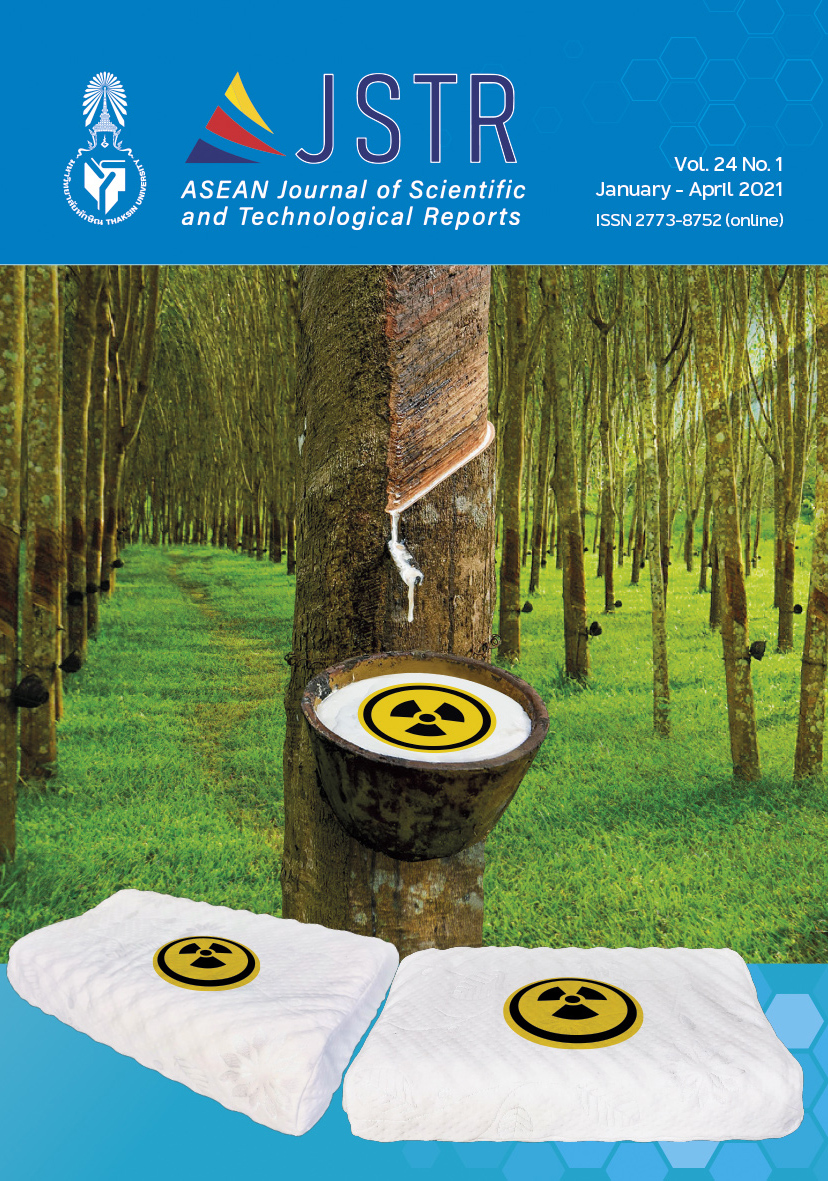Optimized Extraction of Total Phenolic Compounds from 'Tubtim Siam' Pummelo Peel Using Ultrasonic Technique and Response Surface Methodology
Main Article Content
Abstract
The objectives of this research are to optimize extraction condition for total phenolic compounds from 'Tubtim Siam' pummelo peel using ultrasonic assisted extraction and to determine antioxidant activities of the crude extracts. Variables used to study the optimal extraction conditions of total phenolic compounds include concentration of ethanol (10-50 %v/v), extraction time (15-45 min), and ratio of dried pummelo peel: ethanol solution (1:1, 1:2, 1:3). Furthermore, the optimal were determined using a response surface methodology (RSM) by Box Behnken design. The results showed that these three factors affected the yield of extracted total phenolic. Moreover, the statistical analysis provided indications that the data obtained from the experiment should be fitted to polynomial equation because of its high coefficient of determination with R-square = 0.9294. The highest yields of total phenolic compounds were obtained when the samples were dissolved in ethanol at 35%v/v, the extraction time was set at 30 min and the ratio of solid/ethanol was 1:2. Under these optimal conditions, the highest total phenolic compounds yield were 13.67 ± 0.52 mgGAE/gDW from experimental values and 13.66 mgGAE/gDW from predicted values and the scavenging activity of percentage of inhibition by DPPH assay was 32.58 %.
Article Details

This work is licensed under a Creative Commons Attribution-NonCommercial-NoDerivatives 4.0 International License.
References
Lee, H. E., Yeom, J. H., Ha, M. S., & Bae, H. D. (2010). Development of banana peel jelly and its antioxidant and textural properties. Food Science and Biotechnology, 19(2), 449-455. DOI: 10.1007/s10068-010-0063-5.
Toh, J. J., Khoo, H. E., & Azrina, A. (2013). Comparison of antioxidant properties of pomelo (Citrus Grandis (L) Osbeck) varieties. Food Research Journal, 20(4), 1661–1668.
Pichaiyongvongdee, S., Rattanapun, B. & Haruenkit, R. (2014). Total polyphenol content and antioxidant properties in different tissues of seven pomelo (Citrus Grandis (L.) Osbeck) cultivars. Kasetsart Journal (Natural Science), 48(6), 989–996.
Rajha, H. N., El Darra, N., Hobaika, Z., Boussetta, N., Vorobiev, E., Maroun, R. G., & Louka, N.(2014). Extraction of total phenolic compounds, flavonoids, anthocyanins and tannins from grape byproducts by response surface methodology. Influence of solid-liquid ratio, particle size, time, temperature and solvent mixtures on the optimization process. Food and Nutrition Sciences, 5(4), 397–409. DOI: 10.4236/fns.2014.54048.
Junior, M. R. M., Leite, A. V., & Dragano, N. R. V. (2010). Supercritical fluid extraction and stabilization of phenolic compounds from natural sources–review (supercritical extraction and stabilization of phenolic compounds). The Open Chemical Engineering Journal 4, 51–60.
Chemat, F., Tomao, V., & Virot, M. (2008). Ultrasound-assisted extraction in food analysis. In S. Otels (Ed.). Handbook of food analysis instruments. 85–103. Boca Raton, USA: CRC press.
Wang, L., & Weller, C. L. (2006). Recent advances in extraction of nutraceuticals from plants. Trends in Food Science and Technology, 17(6), 300–312.
Hung, P. V., Nhi, N. H. Y., Ting, L. Y., & Phi, N. T. L. (2020). Chemical composition and biological activities of extracts from pomelo peel by products under enzyme and ultrasound assisted extractions. Journal of Chemistry, 2020, 1043251. DOI:10.1155/2020/1043251.
Chooklin, S. (2013). Ultrasound-assisted extraction of phenolic compounds from brown rice and their antioxidant activities. Kasetsart Journal (Natural Science), 47(6), 864–873.
Namjooyan, F., Azemi, M. E., & Rahmanian, V. R. (2010). Investigation of antioxidant activity and total phenolic content of various fractions of aerial parts of Pimpinella barbata (DC.) Boiss. Jundishapur Journal of Natural Pharmaceutical Products, 5(1), 1–5.
Srimun, R., & Tachai, S. (2014). Total phenolic compounds and free radicals scavenging content in processing fruit juice in Chanthaburi province. Rajamangala University of Technology Tawanok Research Journal, 7(1), 24–30.
Lungmann, P., Choorit, W., & Prasertsan, P. (2007). Application of statistical experimental methods to optimize medium for exopolymer production by newly isolated Halobacterium sp. SM5. Electronic Journal of Biotechnology, 10(1), 1–11. DOI:10.2225/vol10-issue5-fulltext-14.
Dahmoune, F., Nayak, B., Moussi, K., Remini, H., & Madani, K. (2015). Optimization of microwaveassisted extraction of polyphenols from Myrtus communis L. leaves. Food Chemistry, 166(1), 585–595. DOI: 10.1016/j.foodchem.2014.06.066.


